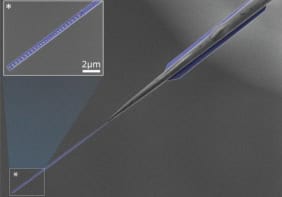
With one face looking back to the past and the other peering forward to the future, Janus was the two-faced Roman god of change. The name, however, is also used in modern science to describe tiny spheres coated on one side with one material and on the other side with another. What is interesting about these “Janus spheres” is that some of them can actually propel themselves in a specific direction when placed in a chemical solution, although why this occurs has been something of a mystery.
Now, however, Manoj Manjare and Yiping Zhao of the University of Georgia, along with Bo Yang of the University of Texas, have shown that Janus spheres actually propel themselves because one of the faces – but not the other – blows bubbles. Researchers are interested in such spheres because they are an example of a kind of “micromotor” that can propel itself through chemical media. Studying such motors could not only shed light on how simple living cells propel themselves but also help scientists to create tiny machines that could, for example, deliver drugs to specific parts of the body.
One family of designs that have shown great promise as micromotors are structures made from two different materials that interact differently with their environment. These could be rods with different materials at either end, or Janus spheres with hemispheres coated in two different materials. One of the materials is often a catalyst such as platinum, which speeds up the rate of conversion of hydrogen peroxide to water and oxygen, for example. The chemical reaction will occur at a much faster rate on the catalyst side of the motor – and this asymmetric release of chemical energy is converted into kinetic energy.
Mysterious mechanisms
However, for many micromotors no one quite knows how the conversion takes place. In the case of the Janus particles, scientists had thought that propulsion involved the creation of oxygen bubbles at the catalyst surface that then leave the surface and impart momentum to the motor. While bubble propulsion has been spotted in tubular micromotors, it had not been seen in spheres – something that is backed up by calculations that suggest that bubbles are unlikely to form on very small spheres because of their relatively large curvatures.
In their new work, Manjare, Zhao and Yang have tried to catch Janus particles in the act of blowing bubbles. The team carried out their experiments in a 5% solution of hydrogen peroxide in water and captured the behaviour of the micromotors using a fast CCD camera. They looked at Janus particles with diameters ranging from 2–50 μm – with one face coated with titanium and the other with platinum.
Minimum diameter for bubbles
Using the camera, the trio found that no bubbles formed on spheres smaller than 10 μm and that bubbles formed more readily as the diameter of the spheres increased – confirming previous calculations. Focusing on individual spheres, the team watched as a bubble formed over about 0.1 s. In the case of a 45 μm sphere, the bubble reached a diameter of about 73 μm before bursting in a process that occurs within 50 μs.
As the bubble grows, the bead is pushed slightly away from the centre of the bubble. But when the bubble bursts, the sudden drop in pressure sucks the bead back, giving it a push in the direction of the platinum face. Although bubble-driven motion has been seen in much larger structures, the team claim that this is the first time this rocking motion has been seen in micromotors. Closer inspection of the camera images reveals that some beads reached a top speed of about 14 cm/s and remained in motion for about 0.2 s before being stopped by the water’s drag.
The trio then created a theoretical description of the propulsion mechanism by combining equations describing the growth of bubbles, the viscous drag of the water and the pressure drop expected when a bubble bursts. The team believes that its theoretical framework could be useful for describing the propulsion mechanisms of other bubble-propelled micromotors and nanomotors. The research is described in Physical Review Letters.



